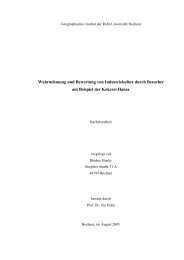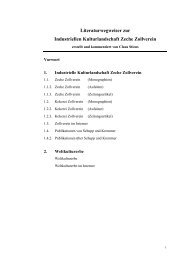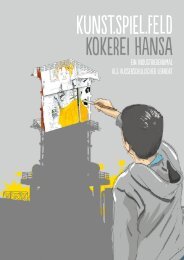Hansa cocking plant - Stiftung Industriedenkmalpflege und ...
Hansa cocking plant - Stiftung Industriedenkmalpflege und ...
Hansa cocking plant - Stiftung Industriedenkmalpflege und ...
Create successful ePaper yourself
Turn your PDF publications into a flip-book with our unique Google optimized e-Paper software.
From coal to coke –<br />
a trip through the production<br />
process in a coking <strong>plant</strong><br />
What is a coking <strong>plant</strong> – a brief introduction<br />
In a coking <strong>plant</strong> coal is loaded into hermetically sealed chambers and<br />
heated to high temperatures in coking ovens arranged in batteries of several<br />
dozen narrow chambers. The coal is then baked in the ovens for aro<strong>und</strong><br />
twenty hours at over 1000 degrees Celsius and the so-called “volatile materials”<br />
are drawn off. This process results in coke .Because of its higher carbon<br />
content, its purity and its calorific solidity coke is a more valuable fuel than<br />
coal. This is why it is primarily used for fuelling blast furnaces producing pig<br />
iron in steel and ironworks<br />
One by-product of the baking process is the crude gas which is then siphoned<br />
out of the ovens. The crude gas not only contains pollutants like hydrogen<br />
sulphide but also ammonia, crude benzene and tar. These so-called by-products<br />
are then separated from the gas in further production steps. Some of<br />
them are cleaned up and sold on as valuable products on the market. When<br />
coke production in Germany was at its height the by-products were important<br />
basic materials for the chemical industry. The cleaned up coking gas – it was<br />
known as rich gas – was sold off as fuel for steel mills and other industrial<br />
factories, or as domestic gas in the Ruhrgebiet. Gas production was a lucrative<br />
business for the coking industry until the mid-1960s when gas suppliers<br />
gradually rejected it in favour of natural gas.<br />
The production process in a coking <strong>plant</strong> is primarily divided into two main<br />
areas. The buildings used for handling the coal and producing the coke<br />
are known as the “black side”, and the by-products from the coking gas are<br />
separated and cleaned up in the buildings on the “white side”. The buildings<br />
in the <strong>Hansa</strong> coking <strong>plant</strong> make it possible for visitors not only to follow the<br />
process of producing coke, but also to get a greater <strong>und</strong>erstanding of the<br />
subsequent processing of the coking gas into its by-products.<br />
The production process in a coking <strong>plant</strong> never stops. For this reason all the<br />
activities including the workers’ shifts have to fulfil a single aim: to ensure<br />
that there are no stoppages whatsoever. Once a battery of coke ovens has<br />
been heated up – a process that often takes several months - it must in no<br />
circumstances be allowed to cool down again, otherwise this will result in<br />
irreparable damage to the walls of the battery. Minor interruptions in the<br />
pressing process, or defective parts must be remedied or replaced whilst the<br />
battery is still in operation. This demands a high level of efficiency not only<br />
from the mechanical parts involved, but also from the workers involved in<br />
maintaining them.<br />
We shall now describes the path of coal and the path of the crude gas as<br />
they pass through the various areas of production in the <strong>Hansa</strong> coking <strong>plant</strong>;<br />
beginning with coal deliveries, continuing with the baking process and ending<br />
with the finished coke and its by-products. The <strong>Hansa</strong> coking <strong>plant</strong> provides<br />
an ideal example of the complex processes involved in such an industrial site.<br />
40<br />
HANSA COKING PLANT – THE HISTORY OF THE INDUSTRIAL MONUMENT<br />
FROM COAL TO COKE 41





